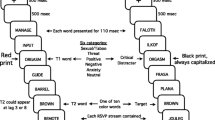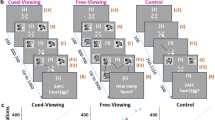Abstract
The attentional blink (AB) is a transient attentional deficit that occurs when two stimuli that must both be detected are presented within an interval of less than 500 ms. Event-related potential (ERP) investigations have suggested that the AB affects a specific component, the P3, which is suppressed when targets are blinked. In view of the link between the P3 and working memory, it has been suggested that the AB might be due to the inability of the blinked target to access working memory. Interestingly, it seems that faces, due to their saliency, might escape the AB effect when cross-category detection is required (i.e., when the targets are composed of faces versus other categories of stimuli). In the present study we investigated this phenomenon in an event-related potential (ERP) study using upright and inverted faces as targets. In a first task, the participants were asked to identify two successive targets, the first composed of geometric shapes and the second of upright or inverted faces. A second control task, identical to the first was also performed, in which only the second targets had to be identified in order to compare ERPs. ERPs and scalp topographies of physically identical sequences of events, differing only by the attentional involvement, were thus compared. Behavioural results showed that faces indeed escape the AB while inverted faces do not. However, the electrophysiological findings showed that when attention was engaged in a previous stimulus (at the shortest lag times), both upright and inverted faces showed a decreased amplitude in the 150–260 ms time period, in addition to a lower P3. At longer lags, when the AB was no longer observed, no ERP differences were found. Our data demonstrate that, although faces escape the attentional blink, previous attentional involvement occurs much earlier than described for other categories of stimuli. This suggests that faces are subjected to an early selection which might allow rapid re-allocation of attention to the stimulus if it is deemed meaningful.





Similar content being viewed by others
Notes
An initial behavioural experiment was carried out with 15 participants who were not involved in the current EEG experiment, using a procedure identical to the one described here, but with SOAs that varied between 0, 85, 170 and 425 ms. On the basis of this pre-test, SOAs of 0 and 425 ms were retained as producing the biggest and the smallest AB effects in our stimuli and the present EEG task was thus carried out with these values.
This result could at first view be attributed to a tendency of the participants to respond “eyes on top” when they were uncertain, i.e., a response bias, however this is unlikely. In our pilot study, 4 stimuli were used: a face, an inverted face, as well as two asymmetrical non-faces in which both eyes were placed in the upper part of the “face” or in the bottom half. At SL, subjects were good at detecting eyes on top in real faces, but not in asymmetric non-faces with the eyes on top. In line with this, the present results seem unlikely to be due to a bias towards the “top” response, but seem most likely linked to the fact that the “real” face escapes the AB.
References
Akyürek EG, Leszczynski M, Schubö A (2010) The temporal locus of the interaction between working memory consolidation and the attentional blink. Psychophysiology 47:1134–1141
Awh E, Serences J, Laurey P, Dhaliwal H, van der Jagt T, Dassonville P (2004) Evidence against a central bottleneck during the attentional blink: multiple channels for configural and featural processing. Cogn Psychol 48(1):95–126
Bentin S, Golland Y (2002) Meaningful processing of meaningless stimuli: the influence of perceptual experience on early visual processing of faces. Cognition 86(1):B1–B14
Bentin S, Allison T, Puce A, Perez E, McCarthy G (1996) Electrophysiological studies of face perception in humans. J Cogn Neurosci 8:551–565
Brandeis D, Lehmann D (1986) Event-related potentials of the brain and cognitive processes: approaches and applications. Neuropsychologia 24(1):151–168
Crist RE, Wu CT, Karp C, Woldorff MG (2007) Face processing is gated by visual spatial attention. Front Hum Neurosci 1:10
Dell’Acqua R, Sessa P, Jolicoeur P, Robitaille N (2006) Spatial attention freezes during the attention blink. Psychophysiology 43:394–400
Downing P, Liu J, Kanwisher N (2001) Testing cognitive models of visual attention with fMRI and MEG. Neuropsychologia 39(12):1329–1342
Eimer M (1998) Does the face-specific N170 component reflect the activity of a specialized eye processor? Neuroreport 9:2945–2948
Eimer M (2000) The face-specific N170 component reflects late stages in the structural encoding of faces. Neuroreport 11:2319–2324
Farah MJ (1996) Is face recognition ‘special’? Evidence from neuropsychology. Behav Brain Res 76(1–2):181–189
Farah MJ, Wilson KD, Drain HM, Tanaka JR (1995) The inverted face inversion effect in prosopagnosia: evidence for mandatory, face-specific perceptual mechanisms. Vision Res 35(14):2089–2093
Furey ML, Tanskanen T, Beauchamp MS, Avikainen S, Uutela K, Hari R, Haxby JV (2006) Dissociation of face-selective cortical responses by attention. Proc Natl Acad Sci USA (103)4:1065–1070
Grave de Peralta Menendez R, Murray MM, Michel CM, Martuzzi R, Gonzalez Andino SL (2004) Electrical neuroimaging based on biophysical constraints. Neuroimage 21(2):527–539
Holmes A, Vuilleumier P, Eimer M (2003) The processing of emotional facial expression is gated by spatial attention: evidence from event-related brain potentials. Brain Res Cogn Brain Res Apr 16(2):174–184
Itier RJ, Taylor MJ (2004) Source analysis of the N170 to faces and objects. Neuroreport 15(8):1261–1265
Jackson MC, Raymond JE (2006) The role of attention and familiarity in face identification. Percept Psychophys 68(4):543–557
Jolicoeur P (1999) Concurrent response-selection demands modulate the attentional blink. J Exp Psych: HPP 25:1097–1113
Jolicoeur P, Sessa P, Robitaille N (2006) On the control of visual spatial attention: evidence from human electrophysiology. Psychol Res 70:414–424
Kok A (2001) On the utility of P3 amplitude as a measure of processing capacity. Psychophysiology 38(3):557–577
Kranczioch C, Debener S, Engel AK (2003) Event-related potential correlates of the attentional blink phenomenon. Brain Res Cogn Brain Res 17(1):177–187
Landau AN, Bentin S (2008) Attentional and perceptual factors affecting the attentional blink for faces and objects. J Exp Psychol Hum Percept Perform Aug 34(4):818–830
Lavie N, Ro T, Russell C (2003) The role of perceptual load in processing distractor faces. Psychol Sci 14(5):510–515
Lehmann D, Skrandies W (1984) Spatial analysis of evoked potentials in man—a review. Prog Neurobiol 23:227–250
Lehmann D, Pascual-Marqui RD, Michel CM (2009) EEG microstates. Scholarpedia 4(3):7632
Luo W, Feng W, He W, Wang N, Luo Y (2009) Three stages of facial expression processing: ERP study with rapid serial visual presentation. Neuroimage 49:1857–1867
Mack A, Pappas Z, Silverman M, Gay R (2002) What we see: inattention and the capture of attention by meaning. Conscious Cogn 11:488–506
Michel CM, Seeck M, Landis T (1999) Spatiotemporal dynamics of human cognition. News Physiol Sci 14:206–214
Michel CM, Thut G, Morand S, Khateb A, Pegna AJ, Grave de Peralta R (2001) Electric source imaging of human brain functions. Brain Res Brain Res Rev 36(2–3):108–118
Michel CM, Murray MM, Lantz G, Gonzalez S, Spinelli L, Grave de Peralta R (2004) EEG source imaging. Clin Neurophysiol 115(10):2195–2222
Oldfield RC (1971) The assessment and analysis of handedness: the Edinburg Inventory. Neuropsychologia 9:97–113
Pascual-Marqui RD, Michel CM, Lehmann D (1995) Segmentation of brain electrical activity into microstates: model estimation and validation. IEEE Trans Biomed Eng 42(7):658–665
Pegna AJ, Khateb A, Spinelli L, Seeck M, Landis T, Michel CM (1997) Unraveling the cerebral dynamics of mental imagery. Human Brain Mapp 5:410–421
Pourtois G, Delplanque S, Michel C, Vuilleumier P (2008) Beyond conventional event-related brain potential (ERP): exploring the time-course of visual emotion processing using topographic and principal component analyses. Brain Topogr 20(4):265–277
Raymond JE, O’Brien JL (2009) Selective visual attention and motivation: the consequences of value learning in an attentional blink task. Psychol Sci 20(8):981–988
Raymond JE, Shapiro KL, Arnell KM (1992) Temporary suppression of visual processing in an RSVP task: an attentional blink? J Exp Psychol Hum Percept Perform 18(3):849–860
Rolke B, Heil M, Streb J, Hennighausen E (2001) Missed prime words within the attentional blink evoke an N400 semantic priming effect. Psychophysiology 38(2):165–174
Sergent C, Dehaene S (2004) Is consciousness a gradual phenomenon? Evidence for an all-or-none bifurcation during the attentional blink. Psychol Sci 15(11):720–728
Sergent C, Baillet S, Dehaene S (2005) Timing of the brain events underlying access to consciousness during the attentional blink. Nat Neurosci 8(10):1391–1400
Shapiro KL, Arnell KM, Raymond JE (1997) The attentional blink. Trends Cogn Sci 1(8):291–296
Spinelli L, Andino SG, Seeck M, Michel CM (2000) Electromagnetic inverse solutions in anatomically constrained spherical head models. Brain Topogr 13(2):115–125
Thierry G, Martin CD, Downing P, Pegna AJ (2007a) Controlling for interstimulus perceptual variance abolishes N170 face selectivity. Nat Neurosci 10:505–511
Thierry G, Martin CD, Downing P, Pegna AJ (2007b) Controlling for interstimulus perceptual variance abolishes N170 face selectivity. Nat Neurosci 10(4):505–511
Vaughan HG Jr (1982) The neural origins of human event-related potentials. Ann N Y Acad Sci 388:125–138
Vogel EK, Luck SJ, Shapiro K (1998) Electrophysiological evidence for a postperceptual locus of suppression during the attentional blink. J Exp Psychol Hum Percept Perform 24:1656–1674
Vuilleumier P (2000) Faces call for attention: evidence from patients with visual extinction. Neuropsychologia 38:693–700
Acknowledgements
This research was supported by the Swiss National Science Foundation grant no. 320030-125196. The Cartool software (http://brainmapping.unige.ch/Cartool.htm) used for analysis in this study was programmed by Denis Brunet from the Functional Brain Mapping Laboratory, Geneva, Switzerland, and is supported by the Center for Biomedical Imaging of Geneva and Lausanne. The authors are indebted to Jane Raymond for constructive comments on a previous version of this paper.
Author information
Authors and Affiliations
Corresponding author
Rights and permissions
About this article
Cite this article
Darque, A., Del Zotto, M., Khateb, A. et al. Attentional Modulation of Early ERP Components in Response to Faces: Evidence From the Attentional Blink Paradigm. Brain Topogr 25, 167–181 (2012). https://doi.org/10.1007/s10548-011-0199-5
Received:
Accepted:
Published:
Issue Date:
DOI: https://doi.org/10.1007/s10548-011-0199-5




